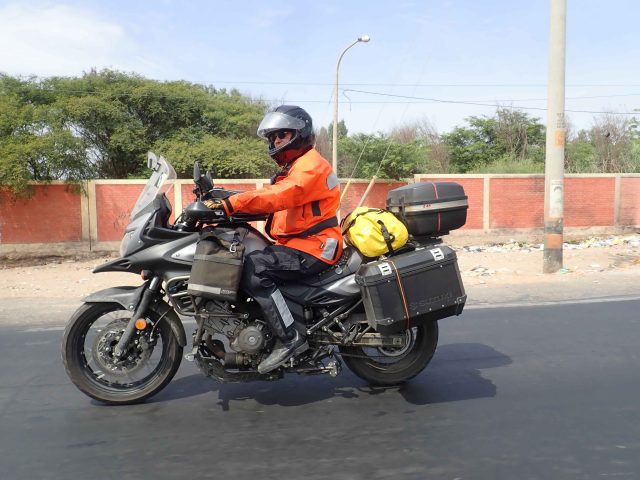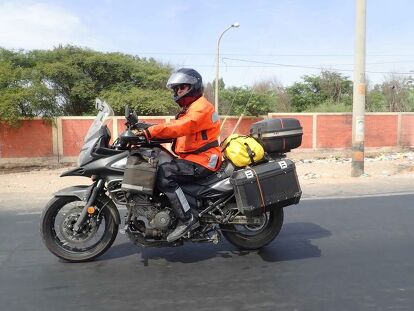Higdon in South America, Part 8: O2 Joy
February 22, 2018
La Paz, Bolivia
https://spotwalla.com/tripViewer.php?id=177dc5a62c0d1d6a1c&hoursPast=0&showAll=yes
The road from Puno, where we took an early morning tour of the floating islands of Lake Titicaca, to La Paz, is 160 miles and as flat as a pool table. We did not vary our altitude – 12,500 feet – so much as 100 feet in two short days of riding. Along the way we would face an “easy” border, saying goodbye to Peru and El Condor Pasa, which judging from the number of times we heard the depressing tune, must be the national anthem – and being welcomed to Bolivia and its president, Evo Morales, that country’s answer to Bernie Sanders.
Jairo and I spent the two-hour jaunt to the frontier teaching each other our respective alphabets and arguing about whether the Spanish “ll,” the 27th letter of their alphabet, should be pronounced the way they do in Argentina or as the rest of the Spanish-speaking world does. Take “llama,” for example, pronounced “YAH-ma” by everyone but the Argentineans and Jairo, who’s from Colombia. He says “SHA-ma.” It’s a soft sound, though irritating and clanky to the non-Argentinean ear. He does another thing with the letter “V,” saying “vista” instead of “bista,” though I hope to be able to disabuse him of that habit quickly. I don’t want him to be embarrassed when he’s speaking in public.
The “easy” border turned into a four-hour suicidathon, made marginally entertaining by watching blood periodically shoot out of nearly everyone’s ears, a morbid sign of terminal boredom and frustration. The basic problem was a new-to-the-game clerk. You could not give her any answer that she did not immediately have to confirm with her supervisor. She was also in charge of looking at VIN plates. That became my problem since my Suzuki’s VIN isn’t located in the same place as the BMW VINs. She was ready to reject me altogether until Jairo explained to her that not every moto in the world is a damned BMW. I could barely watch this blithering charade since I was busy changing the bandages on my ears.
A little while later we were advised that motorcycles cannot be hauled into the country on a trailer because shut up. That meant Bobby would get to ride for a while. It was about an hour’s lope to the hotel, but riders who’d already left reported back that they had run through thunder, lightning, hail, and a military checkpoint along the way. A black storm was crawling up behind us. My phone’s Magic 8 Ball app said that the outlook was “Very doubtful.” It was 20 degrees colder than I’d have liked, but I got dressed, tried to remember where the ignition key went, and followed Helge to the hotel. At least it was still sunny in the late afternoon, and my worthless right eye wasn’t any worse. We didn’t see a drop of rain. Gracias.
I’m not going to embarrass our hotel by naming it. The lady who owns it is a warm, gentle person and an excellent cook. I know she’s doing her best, but Chris sent me a text: “Just read some reviews of your hotel in Trip Advisor. Hope you have something warm to wear to bed.” I was in Room #301 on the top floor. There are 32 steps, each one a dagger to the lungs. The desk clerk begged me not to lose the key. “Es la única,” the only one. I locked it in the room the next morning when I went to breakfast.
The cold wasn’t the worst feature of the night, though it did attract one’s attention. The feral dogs roaming the streets were worse. Even in a Class A hotel in Puno my room featured a small cloth bag of ear plugs. My experience has been that the staff won’t go to that trouble and expense without a reason. More dogs.
My feet had not yet touched the frigid floor the next morning before I realized that I might have left the GPS running all night on the bike. If I had forgotten to turn it off, I would have a dead battery for sure. Dressing as quickly and warmly as possible, I tromped down the 32 steps and out into the parking lot. Jairo had pulled the GPS off the bike the previous evening and had rolled the bike back onto the trailer. Thus did he save me once again. Back up the 32 steps I went to the dining room. I collapsed half-frozen into the nearest empty chair. Almost everyone had already finished breakfast and was now engaged in watching Ron demonstrate the wonders of measuring the partial pressure of oxygen (PO2) in the blood with a pulse oximeter.
I know you may think you have wandered into an episode of The Twilight Zone here. I did as well. Why, you might ask, when every cubic inch of space on a touring bike is as precious as uranium isotopes, is anyone in this group toting such a device? Well, Ron is not quite anyone. His father is Indonesian, his mother Dutch, his wife Korean, and at home in Switzerland the family speaks English. I need not mention that he also rides as if his rear tire is about to catch fire, so I guess if he wants to stick his fellow riders’ fingers in the oximeter, I doubt anyone is going to make a churlish comment. And no one did. They just held out their fingers to be tested. So did I.
I should mention here as a recovering medical malpractice defense lawyer that I used to be paid the big bucks for knowing what the oximeter did and what the numbers meant. So I waited my turn, still recovering from the 32 steps, with a bit of trepidation. The PO2 tells whether the circulatory system is adequately oxygenated. Yours now is in the upper 90s. That’s good. Around our breakfast table the numbers were in the 91-93 range, a result of the diminished oxygen supply at our altitude. When Ron turned to me, he couldn’t get a reading at all. A second try failed with a different index finger. I sat on my hands for a couple of minutes to warm them up. On the third try the device produced a PO2 of 82 and a heart rate of 118.
I sat back but said nothing. This was definitely not good news. Organs begin failing with a PO2 below 80. I checked my respirations: 30, twice normal. I checked my pulse: 88, 40% above normal. With numbers like this I might as well have been at Mt. Everest’s base camp. If that PO2 was accurate, my first stop in La Paz would be the airport, where I’d be booking a seat on the next flight to Santiago and sea level. The only cure for altitude problems is to get out of it.
We spent a couple of hours on a hike around the Tiwanaku ruins. They are ruined ruins, looted thoroughly by grave robbers and invading Spaniards for centuries. I spent most of my time checking my pulse and respirations. They were moderating a bit. I had hoped to have another chance with Ron’s meter, but by the time I’d returned to the hotel he had already fled to La Paz on the heels of The Boys.
Back in the van on the short ride to the city, I continued to fret about that PO2, trying to convince myself it was an aberration. The heart rate reading had clearly been wrong. Surely the inability to get any readings at all initially must have been due to my cold fingers, and they were cold because the small veins and capillaries had been constricted by my having been outside. If there’s not a lot of blood flowing, there’s not going to be a lot of oxygen to measure. When we got to the hotel, I sent a text to Ron, asking to borrow the oximeter. By the time we were able to get together, my pulse and respirations had returned almost to normal. I wasn’t even surprised when the PO2 showed a new and improved reading of 89. No worries and case closed. Now to fix this damned right eye.
More by Robert Higdon
















































Comments
Join the conversation
One of the things a trip to much higher altitudes is good for is uncovering any cardiovascular or pulmonary inadequacies. Lots of O2 at sea level can mask the issues until they are so bad no masking is possible; at high altitudes they can crop up as unpleasant (and deadly) surprises when you thought you were healthy (enough).
This, I guess, is part of what makes this kind of trip an adventure. There are real risks to go with the potential rewards. At this point on this particular trip, based on the reports, I am beginning to think staying out of hospital will be the main reward.